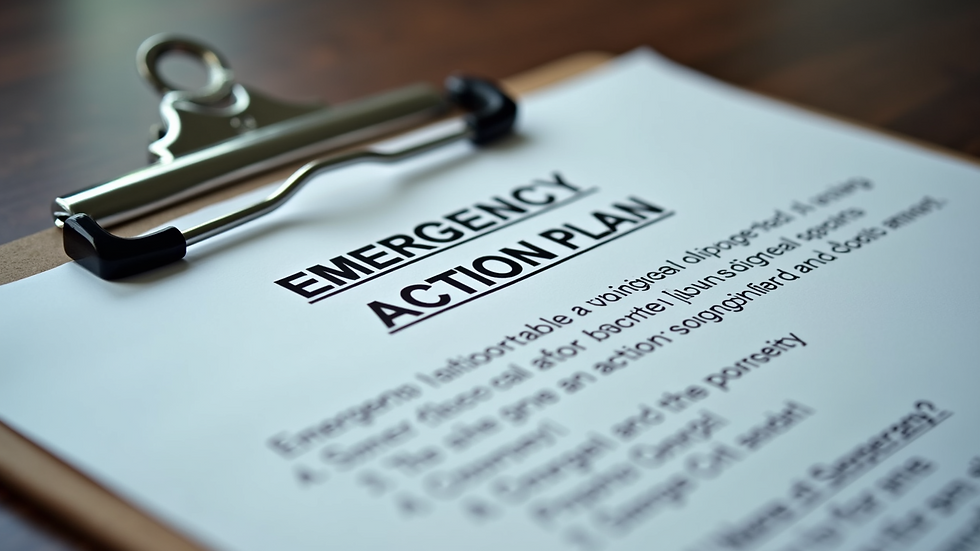Essential Steps for Effective Emergency Response Planning
- Rowan Allsop
- Aug 5
- 3 min read
Emergencies can strike at any time, often without warning. Whether it’s a natural disaster, a fire, or a medical crisis, being prepared can save lives and reduce damage. Effective emergency preparation steps are crucial for individuals, families, and organisations to respond quickly and efficiently. This blog post will guide you through the essential steps to create a robust emergency response plan that ensures safety and readiness.
Understanding Emergency Preparation Steps
Emergency preparation steps involve a series of actions designed to anticipate, respond to, and recover from emergencies. These steps help minimise risks and ensure that everyone knows what to do when disaster strikes. Preparation is not just about having supplies; it’s about planning, training, and communication.
Some key emergency preparation steps include:
Risk Assessment: Identifying potential hazards specific to your location or environment.
Resource Inventory: Gathering necessary supplies such as food, water, first aid kits, and communication devices.
Training and Drills: Practising emergency procedures regularly to build confidence and familiarity.
Communication Plans: Establishing clear methods to contact family members, employees, or emergency services.
Evacuation Routes: Mapping out safe exits and meeting points.
By following these steps, you can create a comprehensive plan that addresses various emergency scenarios.

Key Emergency Preparation Steps for Organisations and Individuals
Whether you are preparing your home or workplace, the following emergency preparation steps are essential:
1. Conduct a Risk Assessment
Start by identifying the types of emergencies most likely to occur in your area. For example, coastal regions may face cyclones or floods, while urban areas might be more prone to fires or power outages. Understanding these risks helps tailor your plan effectively.
2. Develop an Emergency Plan
Create a detailed plan that outlines roles, responsibilities, and procedures. This plan should include:
How to alert people about an emergency.
Steps to take during different types of emergencies.
Locations of emergency exits and shelters.
Contact information for emergency services and key personnel.
3. Assemble Emergency Kits
Prepare kits with essential items such as:
Non-perishable food and water for at least 72 hours.
First aid supplies.
Flashlights and extra batteries.
Important documents and cash.
Personal hygiene items.
4. Train and Educate
Ensure everyone involved understands the plan. Conduct regular training sessions and drills to practice evacuation routes and emergency procedures. This builds confidence and reduces panic during real emergencies.
5. Establish Communication Protocols
Set up reliable communication channels. This could include phone trees, group messaging apps, or radios. Make sure everyone knows how to use these tools and who to contact in different situations.

What are the 5 steps of the emergency action plan?
An emergency action plan (EAP) is a critical component of emergency preparation. It provides a clear, step-by-step guide to follow during an emergency. The five essential steps of an EAP are:
Reporting the Emergency
Quickly notify the appropriate authorities or emergency contacts. This could be calling 000 in Australia or alerting onsite emergency coordinators.
Evacuation Procedures
Follow predetermined evacuation routes and assemble at designated safe areas. Ensure everyone is accounted for.
Emergency Response
Administer first aid if trained, use fire extinguishers if safe, and assist those with special needs.
Communication
Keep communication lines open to provide updates and receive instructions.
Post-Emergency Actions
Conduct headcounts, report injuries, and begin recovery efforts. Review the incident to improve future responses.
Implementing these steps ensures a structured and effective response during emergencies.

Practical Tips for Maintaining Your Emergency Plan
Creating an emergency plan is just the beginning. Maintaining and updating it regularly is vital to ensure its effectiveness. Here are some practical tips:
Review and Update Annually: Circumstances change, so revisit your plan at least once a year.
Involve Everyone: Make sure all family members or employees participate in planning and drills.
Keep Supplies Fresh: Check expiry dates on food, water, and medical supplies regularly.
Use Technology: Leverage apps and alert systems to stay informed about local emergencies.
Coordinate with Local Authorities: Stay connected with emergency services and community groups for support and information.
By staying proactive, you can keep your emergency preparation steps relevant and reliable.
Why Effective Emergency Response Planning Matters
Effective emergency response planning is more than just a checklist. It builds resilience and confidence, reducing the chaos and confusion that often accompany emergencies. A well-prepared plan saves time, protects lives, and minimises property damage.
Whether you are an individual, a family, or part of an organisation, investing time in emergency preparation steps is a smart and responsible choice. It empowers you to face unexpected situations with clarity and calm.
Taking these essential steps today can make all the difference tomorrow. Start planning, stay prepared, and ensure safety for yourself and those around you.



Comments